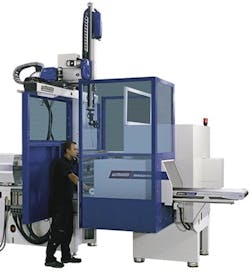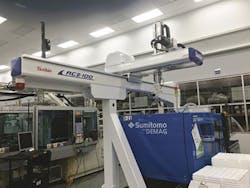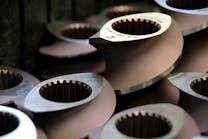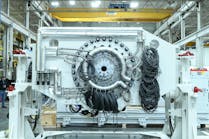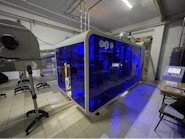Plant Design: Space considerations key when designing plant automation
When designing automation into a new injection molding plant, companies need to consider layout and design, with the No. 1 rule that "you can never have too much space."
Considerations include the amount of floor space required, height requirements for automation, layout of injection molding machines and robots, and location of utilities such as electric lines and ethernet cables.
"The big factor is space," said Jason Long, national sales manager for robots and automation at Wittmann Battenfeld. "If you are talking about designing a new plant, you are wide open in that category."
It's important to consider not only the automation in place when the plant first opens, but automation that might be added later, several experts said.
"The thing with automation is, you need to think about your future products," Long said.
Height
When injection molding companies are designing a new plant they may give considerable thought to the square footage needed, but they also need to consider height requirements for robots, which could be greater than initially expected.
If you are building an injection molding plant, you're most likely going to mount robots on top of the presses, Long said. Molding machines of 1,000 tons or more can be 8 or 9 feet tall and a robot will add 5 to 6 additional feet to the system, he said.
Injection molders don't always take into consideration how much space automation actually takes up, Long said.
John Campbell, national sales manager for Ranger Automation, said ceiling height is one of the top considerations. However, he said it most frequently becomes a problem when robots are being installed in an older plant. There are no firm guidelines for determining the correct height, he said.
"Some of it depends on what you think the injection molding machine sizes are going to be," Campbell said.
He said a good rule of thumb is to provide a minimum of at least 15 feet above the tops of the injection molding machines for immediate and possibly future robot requirements. The space also could be required to accommodate the height of a crane used for moving molds, he said.
"You want to make sure it is not too limited so you can move the molds without interrupting the operation of the robots, which we assume would be operating on top of these machines. That relates to the overhead space, and the crane design would be part of an injection molding plant floor that somebody would be laying out."
When considering plant height, factors to take into consideration include the size of the molding machine, the tie-bar spacing and the maximum size of the parts being molded, said Jim Healy, VP of sales and marketing for Sepro America. All of these factors also influence the proper selection or sizing of the robot for a specific injection molding machine.
"Typically, the most common robots are top-entry robots and are mounted on a stationary platen on the molding machine," Healy said. "If the height restriction above the stationary platen does not allow you to mount a robot on top of the platen, we've got various alternative vertical arm configurations that do a pretty good job of getting around that restriction. But if the clearances available do not allow [it] and it is impossible to come in from the top, that's when you might consider a side-entry-style robot, which would typically be floor-mounted."
Floor-mounted robots tend to be more expensive and take up valuable floor space, which is always at a premium, Healy said.
Another option for height-restricted plants is installing injection molding machines below the floor level.
"In a building where they are limited by a low ceiling, they have possible options," said Jeff Bianchini, operations manager at Sterling Contractors Inc. "In some cases, the machines can be installed in pits."
Floor Space and Machine Layout
Determining the amount of floor space required for an injection molding plant can be difficult.
"In the world of automation, everything is different," Long said. "Automation is kind of custom, but there are some rules of thumb we use with simple automation."
For example, Wittmann Battenfeld usually recommends a 3-foot aisle between molding machines and automation that is on the operator side.
"When you're cramming things in and you need someone to go inside the cell to reach the molding machine to work on it, you're looking to add 3 feet around that machine for someone to do that," he said.
Machine layout can influence how many machines can fit in a designated area, but it also can determine the number of operators required to attend to the automated injection molding machines. Depending on the layout, an operator may have the ability to tend to two, three or even four machines.
"What we find first and foremost is space considerations are the most important thing to consider when laying out the plant because, obviously, the robotics and automation equipment are going to take up additional space beside the machine, either on the operator side, the non-operator side or at the end of the machine," said Christopher Parrillo, national sales manager for Yushin America Inc. "In a lot of situations, companies are looking to maximize the number of machines they can put into their facility, so they are maximizing the use of their manufacturing space by locating the machines closer together."
In these cases, companies often opt for a clamp-traverse (CT) robot, Parrillo said. Some manufacturers refer to CT robots as L-mount or longitudinal-mount robots. They also are known as axial robots.
In the most common automation setup, a robot removes the finished injection molded product from above and deposits it on the non-operator side of the injection molding machine. However, a CT or L-mount robot removes the part and traverses the length of the machine and deposits the product at the clamp end of the press.
That allows parts to be deposited on a conveyor running along the end of the injection molding machines or in a storage area. By avoiding depositing parts beside each machine, it allows machines to be spaced closer together so more of them can fit within the same square footage.
A layout with CT or L-mount robots can conserve space, but the robots, because they need a longer reach, can be more expensive.
"The L-mount is definitely a huge space-saving feature for how you mount a robot and how you design your automation," Wittmann Battenfeld's Long said. "It is a little bit more money because your robot has to have longer reaches and longer beams and strokes, but the design feature does save a lot of space."
A secondary advantage to depositing finished goods at the end of a row of injection molding machines instead of beside each machine is that it can improve workflow.
"It's really getting to be more and more common in our everyday operations to see customers dropping parts at the clamp end of the machine and potentially having six machines lined up in a row with all the parts dropping onto a trunk-line conveyor, and that conveyor is flowing to a work station where maybe one to two workers are taking the product off the conveyor and packaging, sorting or doing whatever they might have to do at that point," Healy said.
While many companies place an emphasis on maximizing floor space, some may emphasize minimizing the number of work cell operators.
"When a plant is considering automation, there are different goals or guidelines they are trying to follow or achieve," Healy said. "For some, it could be as simple as wanting to eliminate one operator at a machine or having an operator work between two molding machines."
If a plant has operators working between two molding machines, one press might have a robot depositing parts on the operator side and the next machine might have a robot depositing parts on the nonoperator side, and an operator in the middle is handling the flow of product between two machines.
"So, now you're putting your people to better use with the ability to manage two work cells instead of one," Healy said. "Every case is a little bit different, but floor space is dollars and putting those dollars to maximum use is critical for any molder in today's market."
Instead of buying an injection molding machine, robot and conveyor separately, one space-saving alternative is buying an injection molding machine and automation all in one.
For example, Wittmann Battenfeld sells the Insider, which includes the machine, robot, conveyor and guarding.
"The Insider allows us to put machines closer together because the guarding takes a much smaller footprint than what you normally have in plants, so you can get additional machines in the same space," said Tom Betts, Wittmann Battenfeld injection molding machine regional sales manager.
"You might be able to fit four or five machines in the same space as you used to fit three because the Insider package tightens up the footprint quite a bit," he said.
Robots installed on the Insider deposit parts onto a conveyor that transports the parts to the clamp-end of the machine.
Wittmann Battenfeld literature states the Insider can save as much as 50 percent of the floor space of a conventional automation system.
Workflow Optimization
When designing for automation, it's important to take workflow into account, said Dino Caparco, engineering manager for Yushin. Even automated work cells need to be supported by humans, so identifying ways to streamline that process is a critical factor. Companies that aren't careful when designing the layout of their plant floor can erase all of the gains they made through automation — especially if they're making parts with multiple components.
Yushin, which in addition to selling take-out robots also advises customers on tooling, software and downstream equipment integration, recommends grouping the manufacturing and assembly areas together. That minimizes the time it takes to transport and store materials, molds and end-of-arm-tooling (EOAT).
"A lot of times, what we will see now is a customer making a three-component part and they are making Part A and Part B in one area of their plant, then they are loading them in boxes and transporting them over to some other part of the plant where they are making Part C, and then they are doing assembly over there,"
Caparco said. "If they are setting it up from the beginning, they should have their machines for A, B and C all in the same general area."
By the same token, if a machine cell will require frequent changing of molds and EAOT, companies should ensure that there is storage space for those items nearby.
Sterling Contractors says its customers increasingly are interested in building platforms over injection molding machines to store molds and EOAT.
"We also build custom end-of-arm tooling racks so their employees who are doing the changeover only have to walk feet versus running throughout the facility looking for tools in a storage area," said Tony Vitale, program manager.
Even those transportation tasks can be automated with proper planning. AGVs — automated guided vehicles — are gaining in popularity, but they need to be given enough space to operate unhindered.
"We keep in mind the length of the vehicle and the turning radius and whatever other obstructions they need to clear" when designing the floor layout, Sterling Contractors' Bianchini said.
Electricity and Connectivity
Finally, companies need to plan for the significant power and connectivity that automation equipment requires. "In addition, with the Internet of Things and all the communication going on, they should have Ethernet connections near the machines" so equipment and robots can communicate with each other, Caparco said.
All cables and wires should be as short as possible, and protected from dust and water by running them overhead or burying them underground, said Subodh Sharma, president and CEO of Oak Tree Engineering. "Underground is very clean once it is done, but it requires much more planning and design for the future and more money," Sharma said. "If you change your plans or make a mistake, it is expensive," he said. "But it certainly gives you much more room for other things in the plant and it looks very clean and neat."
Another advantage to burying cables is that they are better protected. For example, they cannot be hit accidentally by a forklift.
Meanwhile, Sterling Contractors is offering a new type of safety feature, a quick-disconnect power system for individual work cells.
"The way we install the electrical systems today allows for one single point of disconnect for an individual molding machine and all of its ancillary equipment that is associated with that machine," Bianchini said. "It allows for convenience and safety."
Bruce Geiselman, senior staff reporter
bgeiselman@plasticsmachinerymagazine.com
For more information
Oak Tree Engineering LLC,Monroe, Mich., 734-244-5231, www.oaktreellc.com
Ranger Automation Systems Inc.,Millbury, Mass., 508-865-0151, www.rangerautomation.com
Sepro America LLC,Warrendale, Pa., 412-459-0450, www.sepro-america.com
Sterling Contractors Inc.,Shelby Township, Mich., 586-803-0240, www.sterlingcontractorsinc.com
Wittmann Battenfeld Inc.,Torrington, Conn., 860-496-9603, www.wittmann-group.com
Yushin America Inc.,Cranston, R.I., 401-463-1800, www.yushinamerica.com
Bruce Geiselman | Senior Staff Reporter
Senior Staff Reporter Bruce Geiselman covers extrusion, blow molding, additive manufacturing, automation and end markets including automotive and packaging. He also writes features, including In Other Words and Problem Solved, for Plastics Machinery & Manufacturing, Plastics Recycling and The Journal of Blow Molding. He has extensive experience in daily and magazine journalism.

